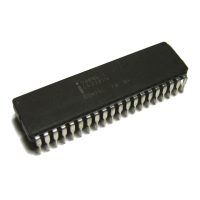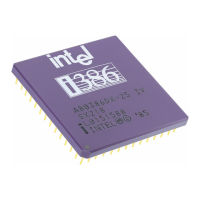80286
BASE ARCHITECTURE
One-operand instructions, such
as
INC
or DEC. The location of the single operand can be speci-
fied
implicitly,
as
in AAM (where the register AX contains the operand), or explicitly,
as
in
INC
(where the operand can be in any register or memory location). Explicitly specified operands are
accessed via one of the addressing modes described in section 2.4.2.
Two operand instructions such
as
MOV, ADD, XOR, etc., generally overwrite
one
of the two
participating operands with the result. A distinction can thus be made between the source operand
(the one left unaffected
by
the operation) and the destination operand (the one overwritten
by
the
result). Like one-operand instructions, two-operand instructions can specify the location of operands
either explicitly or implicitly.
If
an instruction contains two explicitly specified operands, only one
of
them-either
the source or the
destination-can
be in a register or memory location. The other
operand must be in a register or
be
an immediate source operand. Special cases of two-operand
instructions are the string instructions and stack manipulation. Both operands of some string
instructions are in memory and are explicitly specified.
Push and pop stack operations allow trans-
fer between memory operands and the memory based stack.
Thus, the two-operand instructions of the 80286 permit operations of the following sort:
Register-to-register
Register-to-memory
Memory-to-register
Immediate-to-register
Immediate-to-memory
Memory-to-memory
Instructions can specify the location of their operands by means of eight addressing modes, which are
described in sections 2.4.2 and 2.4.3.
2.4.2 Register and Immediate Modes
Two addressing modes are used
to
reference operands contained in registers and instr.uctions:
Register Operand Mode. The operand
is
located
in
one of the 16-bit registers (AX,
BX,
CX, DX,
sr,
DI, SP, or BP) or
in
one of the 8-bit general registers (AR, BR, CR, DR, AL,
BL,
CL, or
DL).
Special instructions are also included for referencing the CS, DS, ES, SS, and Flag registers as
operands also.
Immediate Operand Mode. The operand
is
part of the instruction itself (the immediate operand
element).
2.4.3
Memory Addressing Modes
Six modes are used to access operands in memory. Memory operands are accessed
by
means of a
pointer consisting of a segment selector (see section 2.3.2) and an offset, which specifies the operand's
displacement in bytes from the beginning of the segment in which it resides. Both the segment selector
component and the offset component are 16-bit values. (See section
2.1
for a discussion of segmenta-
tion.) Only some instructions use a full 32-bit address.
2-17
